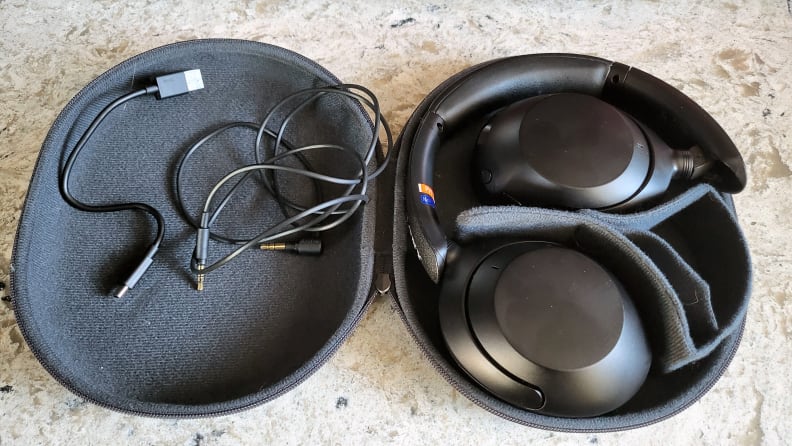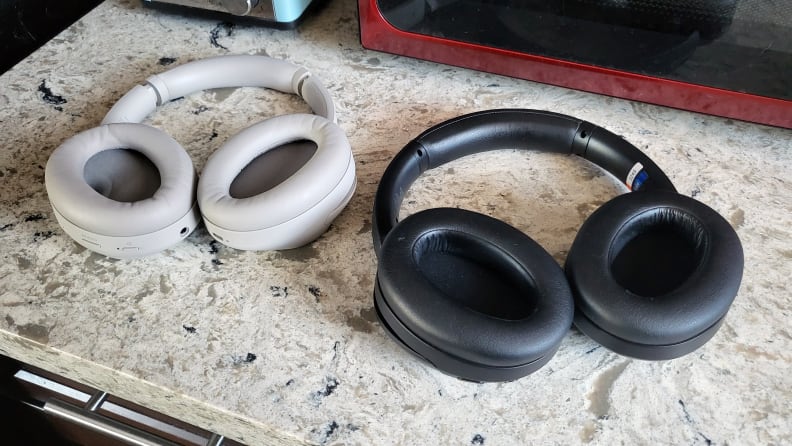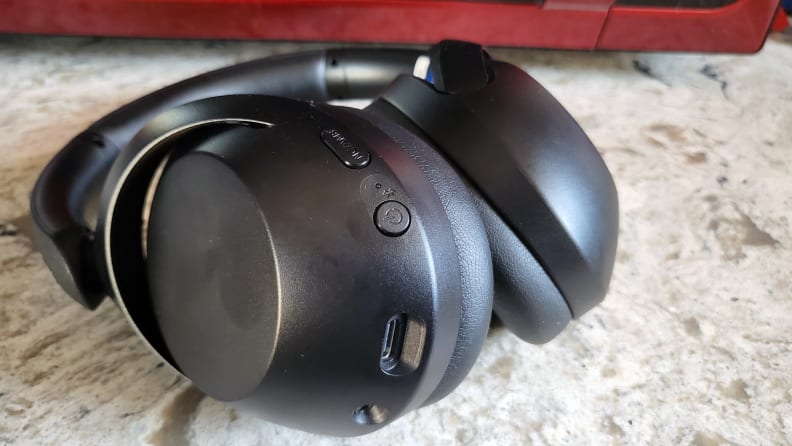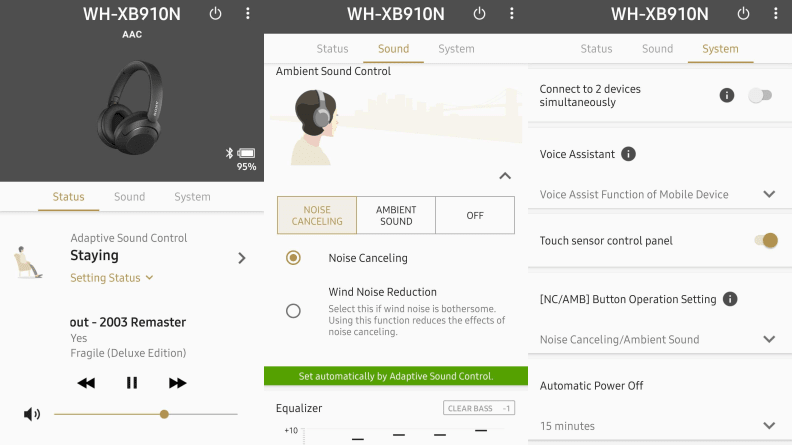Pros
-
Top-tier comfort
-
Solid noise canceling
-
Great battery life
Cons
-
Default sound has too much bass
These comfy cans sport solid noise canceling, bass-friendly sound, and the best of Sony’s well-tooled Headphones Connect app. To keep costs down, Sony has cut the number of exterior ANC microphones from five to two. The company also engineered a Beats-like sound profile that might not appeal as much to audiophiles, but delivers the rumbling bass that many modern listeners love. Plus, you’re still getting Sony’s excellent adjustable EQ and adaptive noise canceling modes, just like on the flagship XM4. It’s a rather robust package for $250, all told.
On the other hand, the XB910N can be seen as a less capable version of the XM4, which retail at $348 but can regularly be found for around $280 online—about $30 more than the XB910N. Unless you’re really strapped for cash, the XM4 are better at noise canceling and more balanced in their sound profile, making them well worth the additional $30. Of course, we can’t predict the future, but it’s very likely the XB910N will become available at a lower price point just like the XM4 have. If you can find them for around $200 (or less) around the holidays, they’re well worth grabbing.
About the Sony WH-XB910N
Here are the XB910N’s vital specs at a glance:
- Price: $249.99
- Style: Over-ear
- Ambient sound modes: Adaptive Sound Control (Noise Canceling and Ambient Sound)
- Battery life: Up to 30 hours with ANC, 50 hours without
- Rapid Charging: 10 minutes of charging for 4.5 hours of playback
- Passive operation: Yes (3.5mm cable included)
- Voice assistants: Amazon Alexa and Google Assistant compatible
- Weight: 252 grams
- Bluetooth version: Bluetooth 5.2
- Colors: Black, Blue

Alongside the headphones, you're getting a compact zip-up carrying case, a 3.5mm cable for passive listening, and a USB-C charging cable
In the box, you’re getting the headphones, a handsome and compact zip-up case, a USB-C charging cable, and a 3.5mm cable for passive listening. We received our Sony WH-XB910N review sample on loan from Sony.
What we like
High-end fit at a mid-level price
We love a lot of things about Sony’s higher-end headphones like the XM4 and XM3 before them, not the least of which is their comfort—and the WH-XB910N don’t break from that tradition, despite being notably cheaper where MSRP is concerned.
The XB910N are hugely successful copycats. My wife and I took turns wearing both the XM4 and the XB910N back to back and could barely tell the difference.

The WH-XB910N (right) are almost identical in weight and form factor to Sony's top-tier WH-1000XM4 (left).
Objectively, the differences are also negligible. Both headphones weigh about 252 grams, and feature similar amounts of padding on their ear cups and bands. The XB910N are not as sleek as the pricier XM4, featuring somewhat bulkier ear cups which gives them a more clamped-on, closed-in feel, despite weighing roughly the same. To quote my wife, “It feels like there’s extra padding [compared to the XM4], but it doesn’t make them more comfortable.” I wholly agree with that assessment.
Despite that slight additional density, however, the XB910N are still plenty comfortable, and Sony deserves kudos for making the comfort and form factor of its flagship headphones available in a product that retails for $100 less.
They're easy to use
Fully capacitive tap and swipe touch controls were one of our favorite features in the XM4, and the XB910N follow suit. Adjusting volume, jumping forward or backward through a playlist, playing/pausing music, or taking a call are all handled via touch controls on the surface of the right cup. Having used the XM4 extensively, I found this manner of control extremely intuitive, and was able to use the XB910N flawlessly right out of the box.

Other than the power and ANC mode buttons on the back of the left ear cup, controlling the XB910N is handled entirely by touch/swipe controls.
Even if you haven’t used these kinds of touch controls before, rest assured that they’re quite easy to learn once you have an hour or so to use them. You’ll find a few things to consider on the left cup, as well, including the main power button, a quick toggle button for ANC/transparency mode, and inputs for both the USB-C charging cable and 3.5mm cable for passive listening.
If you’re a physical buttons die-hard, I encourage you to try out the touch controls on some of Sony’s upper-tier headphones. Once you get the gestures under your fingers, it’s a refreshingly simple way to control things.
Great battery life
Another strong suit for the XB910N is their battery life. You’ll get roughly 30 hours of playback (with ANC) per charge, and almost twice that without ANC. This is essentially the same great battery life you get from the flagship XM4, and better than the recently released Bose QC45 for $100 less.
Good enough noise canceling
One of the major physical differences between the XB910N and the flagship XM4 is the amount of microphones dedicated for ANC. The XM4 have five microphones, while the XB910N only have two. It makes a difference, but not so much that the noise canceling isn’t still a great addition to the whole package.

While the XB910N don't sport the same stellar ANC as the pricier XM4, what you get is definitely good enough for most use cases.
In a side-by-side comparison, I can still hear occasional ambient noise while at home or out and about in the XB910N that the XM4 manage to block out. Things like squealing truck brakes or even my own tapping on a keyboard tend to break through the XB910N’s canceling, while the XM4 does a better job of consistently quieting these breakout, high-pitched sounds.
Of course, many noise cancelers fall short of the XM4, which until recently were our top-rated ANC headphones; (Bose’s QC45 take that honor now). That said, for what you’re paying, the XB910N’s noise canceling—and its automatic adaptive modes, which are discussed in the next section—is certainly good enough for the wide majority of people hoping to quiet down the world around them.
Stellar features and extras
As previously stated, one of the best things about the XB910N is access to so many of the same great features and extras you get with the flagship XM4.
This includes Sony’s full Adaptive Sound Control suite, designed to adapt to your activities in order to optimize noise canceling for various real-world situations. For example, while I sit here writing, it has defaulted to “Staying” mode. But when I get up to walk around, a chime will eventually sound as it shifts to “Walking” mode. There are also “Running” and “Commuting” modes, etc., each tuned to optimize the amount of canceling for what the user is likely to encounter during the activity.
You can see (and adjust) almost all of this directly in the Sony Headphones Connect app, an indispensable part of getting the most out of the XB910N. Not only can you toggle Noise Canceling, Ambient Sound, and even Wind Noise Reduction in the app, but this is also where you’ll find adjustable EQ and EQ presets.

Sony's Headphones Connect app provides a robust suite of ways to customize how the XB910N sound and operate
These EQ presets are especially useful for dampening XB910N’s very bass-heavy sound. If you don’t like the sound (which is admittedly quite bass-heavy even on presets that reduce bass), it’s very easy to jump through until you find something that suits you better. While I enjoy bass as much as the next person, I’m a fan of the more balanced sound you’ll get from pricier over-ear cans, and have found myself defaulting to the “Bright” EQ preset, which slightly reduces bass while boosting upper midrange and treble frequencies a hair.
While I wouldn’t call it a selling point, Sony deserves some kudos for including Sony's proprietary 3D audio mode in the XB910N, 360 Reality Audio. Like Apple’s Spatial Audio mode, 360 RA is a dynamic/immersive surround sound imitator designed to allow music and sounds to appear to be all around you in a spherical soundstage. It’s a pretty fun way to experience music and certain activities, but content is also limited and cordoned off into just a few services like Tidal HD.
That's only part of everything you can do in the app. The large degree of flexibility and customization available is a huge win for the XB910N, and goes a long way toward mitigating their singular drawback.
What we don’t like
A little too much bass
The XB910N really lean into their “Xtra Bass” designation, and if it weren’t for the sound flexibility provided by the app’s EQ presets and custom EQ modes, I’d find these headphones a bit harder to recommend.
As it stands, most listeners will likely be fine with the XB910N's sound by default, but if you’re looking for a flatter, more balanced soundscape, you’re going to have to do some tinkering. Even on presets that claim to reduce bass by seven or eight levels, there’s still a lot of rumblin’ low end to contend with.
To my ears, the extra punch can make things sound a bit muffled and it lacks a certain sparkle—but the “Bright” EQ preset does enough to remedy this, making it a mild complaint rather than a major issue.
Should you buy them?
Yes—but wait till the price drops
Right now, Sony’s biggest competition for the XB910N comes from… Sony. Unless you’re just gaga for Sony’s “Xtra Bass” sound, and more power to you, the price point between the XB910N and the sale price of the XM4 is just too close. The XM4’s online price regularly falls to around $280 (or less). At just $30 difference, we’ll take the XM4 every time.
However, comparisons aside, the XB910N are still an excellent “de facto” value. For $250, they do a bang-up job emulating the best parts of the XM4, which—considering those headphones list for almost $100 more—is really saying something. They’ve inherited the best software aspects of Sony’s flagship headphones, too. If it weren’t for the XM4, we’d be crowing about what a great value the XB910N is.
Which you should buy all comes down to cost: If you can land the XM4 at $280 or less, they're impossible to pass up. If not, or if the XB910N drop a sale of their own, they could be an excellent way to get most of the spoils from Sony's flagship pair at a bargain.
Meet the tester
Lee was Reviewed's point person for most television and home theater products from 2012 until early 2022. Lee received Level II certification in TV calibration from the Imaging Science Foundation in 2013. As Editor of the Home Theater vertical, Lee oversaw reviews of TVs, monitors, soundbars, and Bluetooth speakers. He also reviewed headphones, and has a background in music performance.
Checking our work.
Our team is here to help you buy the best stuff and love what you own. Our writers, editors, and experts obsess over the products we cover to make sure you're confident and satisfied. Have a different opinion about something we recommend? Email us and we'll compare notes.
Shoot us an email

